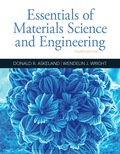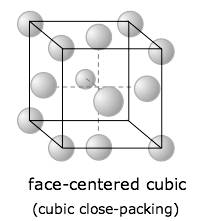
Essentials Of Materials Science And Engineering
4th Edition
ISBN: 9781337670845
Author: ASKELAND
Publisher: Cengage
expand_more
expand_more
format_list_bulleted
Question
Chapter 15, Problem 15.8P
Interpretation Introduction
Interpretation:
The three-equivalent position of Zn ions using S as basis for the given condition should be determined.
Concept introduction:
Face centered cubic cell is an arrangement of atoms in crystals having one atom at each corners of cube and one at the center of each face. It is the simplest form of repeating unit of a cubic closed packed structure.
FCC having coordination number of 12 with 4 atoms per unit cell.
The cubic structure for FCC is shown below:

Expert Solution & Answer
Want to see the full answer?
Check out a sample textbook solution
Students have asked these similar questions
1.2 m
BX B
70 kN.m
y = 16 kN/m³
c' = 0
6'-30°
Water table
Ysat
19 kN/m³
c' 0
&' = 30°
A square foundation is shown in the figure above. Use FS = 6, and determine the size of the foundation. Use the Prakash and Saran theory (see equation and figures below). Suppose that F =
450 kN.
Qu
= BL
BL[c′Nc(e)Fcs(e) + qNg(e)Fcs(e) + ·
1
YBN(e) F
2
7(e) Fra(e)]
(Enter your answer to two significant figures.)
B:
m
Na(e)
60
40-
20-
e/B=0
0.1
0.2
0.3
.0.4
0
0
10
20
30
40
Friction angle, ' (deg)
Figure 1 Variation of Na(e) with o'
Ny(e)
60
40
20
e/B=0
0.3
0.1
0.2
0.4
0
0
10
20
30
40
Friction angle, ' (deg)
Figure 2 Variation of Nye) with o'
K/S
46. (O
المهمات
الجديدة 0
المنتهية 12
المغـ
۱۱:۰۹
search
ليس لديك اي مهمات
☐
○
☑
11.54 For the network in Fig. 11.73, find the complex
power absorbed by each element.
120/-20° V
Figure 11.73
For Prob. 11.54.
| +
-1302
j5Q
4 Ω
Chapter 15 Solutions
Essentials Of Materials Science And Engineering
Ch. 15 - Prob. 15.1PCh. 15 - Prob. 15.2PCh. 15 - Prob. 15.3PCh. 15 - Prob. 15.4PCh. 15 - Prob. 15.5PCh. 15 - Prob. 15.6PCh. 15 - Prob. 15.7PCh. 15 - Prob. 15.8PCh. 15 - Prob. 15.9PCh. 15 - Prob. 15.10P
Ch. 15 - Prob. 15.11PCh. 15 - Prob. 15.12PCh. 15 - Prob. 15.13PCh. 15 - Prob. 15.14PCh. 15 - Prob. 15.15PCh. 15 - Prob. 15.16PCh. 15 - Prob. 15.17PCh. 15 - Prob. 15.18PCh. 15 - Prob. 15.19PCh. 15 - Prob. 15.20PCh. 15 - Prob. 15.21PCh. 15 - Prob. 15.22PCh. 15 - Prob. 15.23PCh. 15 - Prob. 15.24PCh. 15 - Prob. 15.25PCh. 15 - Prob. 15.26PCh. 15 - Prob. 15.27PCh. 15 - Prob. 15.28PCh. 15 - Prob. 15.29PCh. 15 - Prob. 15.30PCh. 15 - Prob. 15.31PCh. 15 - Prob. 15.32PCh. 15 - Prob. 15.33PCh. 15 - Prob. 15.34PCh. 15 - Prob. 15.35PCh. 15 - Prob. 15.36PCh. 15 - Prob. 15.37PCh. 15 - Prob. 15.38PCh. 15 - Prob. 15.39PCh. 15 - Prob. 15.40PCh. 15 - Prob. 15.41PCh. 15 - Prob. 15.42PCh. 15 - Prob. 15.43PCh. 15 - Prob. 15.44PCh. 15 - Prob. 15.45PCh. 15 - Prob. 15.46PCh. 15 - Prob. 15.47PCh. 15 - Prob. 15.48PCh. 15 - Prob. 15.49PCh. 15 - Prob. 15.50DPCh. 15 - Prob. 15.51CPCh. 15 - Prob. K15.1KPCh. 15 - Prob. K15.2KPCh. 15 - Prob. K15.3KP
Knowledge Booster
Similar questions
- Find a value of RL that can be connected to terminals a-b for maximum power transfer. Then, calculate maximum power that can be delivered to load RL.arrow_forwardI need help setti if this problem up and solving. I keep doing something wrong.arrow_forwardA modulating signal f(t) is bandlimited to 5 kHz is sampled at a rate of 15000 samples/sec. The samples are quantized into 128 levels. Calculate the transmission bandwidth if the following modulation types are used for signal transmission: 4- ASK 5- 8-PSK 6- FSK with Af = 25 kHzarrow_forward
- A modulating signal f(t) is bandlimited to 5 kHz is sampled at a rate of 15000 samples/sec. The samples are quantized into 128 levels. Calculate the transmission bandwidth if the following modulation types are used for signal transmission: 4- ASK 5- 8-PSK 6- FSK with Af = 25 kHzarrow_forward1.0 m (Eccentricity in one direction only)=0.15 m Call 1.5 m x 1.5m Centerline An eccentrically loaded foundation is shown in the figure above. Use FS of 4 and determine the maximum allowable load that the foundation can carry if y = 18 kN/m³ and ' = 35°. Use Meyerhof's effective area method. For '=35°, N = 33.30 and Ny = 48.03. (Enter your answer to three significant figures.) Qall = kNarrow_forwardRecall that the CWH equation involves two important assumptions. Let us investigate how these assumptions affect the accuracy of state trajectories under the control inputs optimized in (a) and (b). (c.1): Discuss the assumptions about the chief and deputy orbits that are necessary for deriving CWH.arrow_forward
- Over the last year, you have been working as a product manager in a technology company, experimenting with launching new digital products. You introduced different types of software applications (productivity, gaming, finance, and health) in various markets (North America, Europe, and Asia). You also considered the company's scale (startup or enterprise) and different marketing strategies (organic growth vs. aggressive paid marketing). After a year, you gathered all the results (see the table below) and analyzed whether each product launch was successful. Now, you would like to build a decision tree that will help guide future product launches. 5 Your task is to construct the most effective decision tree based on the dataset below and explain why it is the best one. In this exercise, you should experiment with two metrics: first, use the Gini impurity metric, and then build another tree, but this time using entropy. While working out these decision trees, you might encounter ambiguous…arrow_forwardplease calculate for mearrow_forwardPROBLEM 2.50 1.8 m The concrete post (E-25 GPa and a = 9.9 x 10°/°C) is reinforced with six steel bars, each of 22-mm diameter (E, = 200 GPa and a, = 11.7 x 10°/°C). Determine the normal stresses induced in the steel and in the concrete by a temperature rise of 35°C. 6c " 0.391 MPa 240 mm 240 mm 6₁ = -9.47 MPaarrow_forward
- I need help on this question. step by step calculations and answers.arrow_forwardDon't use ai to answer I will report you answerarrow_forwardjan G(f) f Sketch the spectrum of g(t), which has a maximum frequency of 5 kHz, if it is sampled at the following sampling frequencies: 7 kHz, 10 kHz and 15 kHz. Indicate if and how the signal can be recovered at each sampling frequency.arrow_forward
arrow_back_ios
SEE MORE QUESTIONS
arrow_forward_ios
Recommended textbooks for you
 MATLAB: An Introduction with ApplicationsEngineeringISBN:9781119256830Author:Amos GilatPublisher:John Wiley & Sons Inc
MATLAB: An Introduction with ApplicationsEngineeringISBN:9781119256830Author:Amos GilatPublisher:John Wiley & Sons Inc Essentials Of Materials Science And EngineeringEngineeringISBN:9781337385497Author:WRIGHT, Wendelin J.Publisher:Cengage,
Essentials Of Materials Science And EngineeringEngineeringISBN:9781337385497Author:WRIGHT, Wendelin J.Publisher:Cengage, Industrial Motor ControlEngineeringISBN:9781133691808Author:Stephen HermanPublisher:Cengage Learning
Industrial Motor ControlEngineeringISBN:9781133691808Author:Stephen HermanPublisher:Cengage Learning Basics Of Engineering EconomyEngineeringISBN:9780073376356Author:Leland Blank, Anthony TarquinPublisher:MCGRAW-HILL HIGHER EDUCATION
Basics Of Engineering EconomyEngineeringISBN:9780073376356Author:Leland Blank, Anthony TarquinPublisher:MCGRAW-HILL HIGHER EDUCATION Structural Steel Design (6th Edition)EngineeringISBN:9780134589657Author:Jack C. McCormac, Stephen F. CsernakPublisher:PEARSON
Structural Steel Design (6th Edition)EngineeringISBN:9780134589657Author:Jack C. McCormac, Stephen F. CsernakPublisher:PEARSON Fundamentals of Materials Science and Engineering...EngineeringISBN:9781119175483Author:William D. Callister Jr., David G. RethwischPublisher:WILEY
Fundamentals of Materials Science and Engineering...EngineeringISBN:9781119175483Author:William D. Callister Jr., David G. RethwischPublisher:WILEY

MATLAB: An Introduction with Applications
Engineering
ISBN:9781119256830
Author:Amos Gilat
Publisher:John Wiley & Sons Inc

Essentials Of Materials Science And Engineering
Engineering
ISBN:9781337385497
Author:WRIGHT, Wendelin J.
Publisher:Cengage,

Industrial Motor Control
Engineering
ISBN:9781133691808
Author:Stephen Herman
Publisher:Cengage Learning

Basics Of Engineering Economy
Engineering
ISBN:9780073376356
Author:Leland Blank, Anthony Tarquin
Publisher:MCGRAW-HILL HIGHER EDUCATION

Structural Steel Design (6th Edition)
Engineering
ISBN:9780134589657
Author:Jack C. McCormac, Stephen F. Csernak
Publisher:PEARSON

Fundamentals of Materials Science and Engineering...
Engineering
ISBN:9781119175483
Author:William D. Callister Jr., David G. Rethwisch
Publisher:WILEY